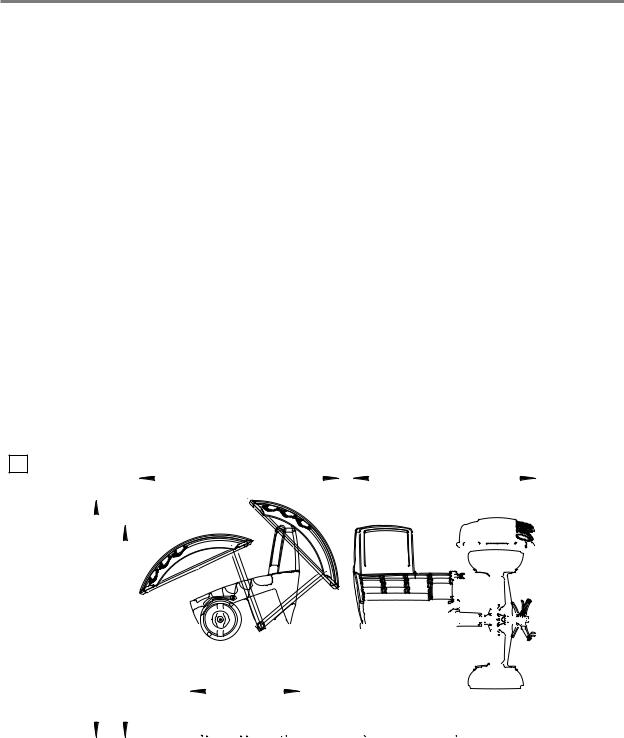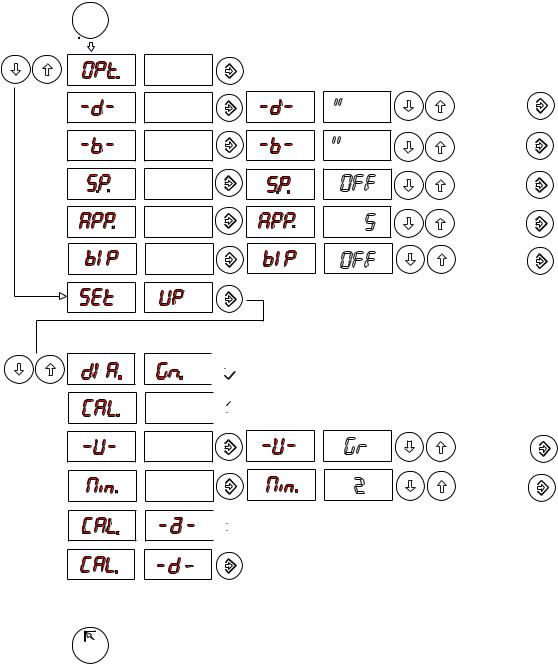CEMB USA C71-2 -B User Manual

Instructions for use |
|
I |
Table of contents |
Page |
|
|
|
|
|
|
1 - GENERAL |
|
3 |
|
1.1 |
- GENERAL SAFETY REGULATIONS |
|
3 |
|
1.1.1 - STANDARD SAFETY DEVICES |
|
3 |
1.2 |
- FIELD OF APPLICATION |
|
3 |
1.3 |
- OVERALL DIMENSIONS |
|
3 |
1.4 |
- TECHNICAL DATA |
|
3 |
2 - HANDLING AND LIFTING |
|
4 |
|
3 - STARTUP |
|
4 |
|
3.1 |
- ANCHORING |
|
4 |
3.2 |
- ELECTRICAL CONNECTION |
|
4 |
3.3 |
- FLANGE MOUNTING |
|
4 |
3.4 |
- WHEEL GUARD ASSEMBLY AND ADJUSTMENT (OPTIONAL) |
|
4 |
3.5 |
- WD SPACER |
|
5 |
4 - CONTROLS AND COMPONENTS |
|
5 |
|
4.1 |
- AUTOMATIC DISTANCE AND DIAMETER GAUGE |
|
5 |
4.2 |
- KEYBOARD AND DISPLAY |
|
5 |
|
4.2.1 FUNCTION MENU MANAGEMENT |
|
6 |
5 - INSTRUCTIONS FOR USE OF THE WHEEL BALANCER |
|
7 |
|
5.1 |
- USING THE GAUGE INSTALLED ON THE MACHINE |
|
7 |
|
5.1.1 - DATA SETTING |
|
7 |
5.2 |
- AUTOMATIC PRESETTING |
|
7 |
|
5.2.1 - STEEL OR ALUMINUM WHEEL RIMS. SPRUNG COUNTERWEIGHTS |
|
7 |
|
5.2.1.1 - STATIC & COMBINED MODES |
|
8 |
|
5.2.2 - RIMS WITH INTERNAL COUNTERWEIGHT |
|
8 |
5.3 |
- MEASUREMENT RESULT |
|
9 |
|
5.3.1 - MEASUREMENT PRECISION |
|
9 |
5.4 |
- RECALCULATION OF THE UNBALANCE VALUES |
|
9 |
5.5 |
- EXACT POSITIONING OF THE ADHESIVE WEIGHT BY MEANS OF THE GAUGE WITH CLIPS |
9 |
|
5.6 |
- SPLIT FUNCTION |
|
10 |
5.7 |
- UNBALANCE OPTIMIZATION |
|
11 |
5.8 |
- AUTOMATIC MINIMISATION OF STATIC UNBALANCE |
|
12 |
6 - SET-UP |
|
12 |
|
6.1 |
- AUTODIAGNOSTICS |
|
12 |
6.2 |
- AUTOCALIBRATION |
|
12 |
6.3 |
- MANUAL DIMENSION PRESETTING |
|
13 |
|
6.3.1 - STEEL WHEEL RIMS |
|
13 |
|
6.3.2 - ALU S RIMS |
|
13 |
|
6.3.2.1 - ALU-S VARIANT WITH INSIDE CLAMP WEIGHT |
|
14 |
6.4 |
- DISPLAY SAVER |
|
15 |
6.5 |
- AUTOMATIC GAUGES CALIBRATION |
|
15 |
|
6.5.1 - RIM DISTANCE GAUGE |
|
15 |
|
6.5.2 - DIAMETER GAUGE |
|
16 |
7 - ERRORS |
|
17 |
|
7.1 |
- INCONSISTENT UNBALANCE READINGS |
|
18 |
8 - ROUTINE MAINTENANCE |
|
18 |
|
8.1 |
- REPLACING THE PROTECTION FUSES |
|
18 |
9 - LIST OF RECOMMENDED SPARE PARTS |
|
19 |
|
|
|
|
|
I 0539 GB - 1
I 0539 GB - 2

1 - General
1.1 - General safety regulations
-The wheel balancer may only be used by duly authorized and trained personnel.
-The wheel balancer must not be used for purposes other than those described in the instruction manual.
-The wheel balancer must not be modified in any way except for those modifications made
explicitly by the manufacturer.
-Do not remove the safety devices. Any work on the machine must be carried out by specialised personnel only.
-Avoid using strong jets of compressed air for cleaning.
-Use alcohol to clean plastic panels or shelves (AVOID LIQUIDS CONTAINING SOLVENTS).
-Before starting the wheel balancing cycle, make sure that the wheel is securely locked on the flange.
-The machine operator must not wear clothes with flapping parts. Do not allow unauthorized personnel to approach the wheel balancer when the cycle is running.
-Avoid placing objects in the base which could impair the correct operation of the wheel balancing machine.
-Before disassembling the weight shelf, remove the guard (see specific instructions)
1.1.1 - Standard safety devices
-Stop push button for stopping the wheel under emergency conditions.
-The wheel guard is not compulsory since the rotation speed is less than 100 min-1.
1.2 - Field of application
The machine is designed for balancing wheels of cars, light commercial vehicles or motorcycles weighing less than 75 kg. It can be operated in a temperature range of 0° to + 45° C.
1.3 - Overall dimensions
1 |
1167 |
1080 |
1395 |
1244 |
640
1.4 - Technical data
Single-phase power supply |
230 V - 50/60 Hz (on request 115 V) |
Protection class |
IP 54 |
Max. power absorbed |
1,5 KW (2,5 Kw / 115 V) |
Breakaway Current |
13 A (35 A / 115 V) |
Balancing speed |
< 100 min-1 |
Cycle time for average wheel |
16 kg - 175 /65x15") 3,8 seconds |
Max. resolution of measurement |
1 gram |
Position resolution |
± 1.4 ° |
Average noise |
< 70dB (A) |
Rim-machine distance |
0 - 270 mm |
Rim width setting range |
1.5” - 20” or 40 - 510 mm |
Diameter setting range |
10” - 30" or 265 - 765 mm |
I 0539 GB - 3

2 - Handling and lifting
2 |
2a |
NOTE: DO NOT LIFT THE WHEEL
BALANCER USING OTHER GRIPS.
3 - Startup
3.1 - Anchoring
The machine can operate on any flat non resilient floor.
Make sure that the machine rests solely on the three support points provided (Fig.2a).
3.2 - Electrical connection
The machine is supplied with a single-phase mains cable plus earth (ground). (any extension cables must have a cross-section of no less than 2.5 mm2).
The power supply voltage (and mains frequency) is indicated on the machine identification plate and cannot be changed. Connection to the mains must always be made by expert personnel.
The machine must not be set up without proper earthing.
Connection to the mains should be through a slow acting safety switch rated at 16A(230V) or 40A(115V). See enclosed diagrams.
3.3 - Flange mounting
3
A |
B |
The wheel balancer is supplied complete with cone flanges |
|
for fixing wheels with a central hole. To mount other optional flange |
|
|
|
adaptors : |
|
|
a) Remove the threaded end-piece A after unscrewing the screw B. |
|
|
b) Mount the new flange (see attached sheets). |
|
|
NOTE: CAREFULLY CLEAN THE COUPLING SURFACES BEFORE |
|
|
PERFORMINGANY OPERATION. |
3.4 - Wheel guard assembly and adjustment (optional)
a) Fix the components to the base as described in the attachment “WHEEL GUARD ASSEMBLY SEQUENCE” at the end of the manual.
Note: Do not lean on the guard during the wheel balancing cycle.
I 0539 GB - 4

3.5 - WD spacer
3a |
DC |
WD |
Cone |
|
|
|
|
|
Spring |
|
|
To move the wheel away from the machine side (e.g. for very wide wheels), fit the WD spacer on the flange body
and secure it with the standard issue nuts. When centring thewheelwithconefromtheinside,mounttheDCspacer to obtain spring thrust. These devices are optionals (see flange details enclosed).
4 - Controls and components
4.1 - Automatic distance and diameter gauge
Allows automatic measurement of the distance from the machine and the wheel diameter at the counterweight application point. The same gauge can be used to position the counterweights correctly inside the wheel, using the specific function that suggests the position memorised during measurement inside the rim.
4.2 - Keyboard and display
4
6 |
1 |
|
2 |
|
|
|
|
|
|
7 |
|
|
|
10 |
8 |
3 |
|
4 |
11 |
|
|
|
||
9 |
|
15 |
|
12 |
|
|
|
|
|
|
|
|
|
13 |
|
|
|
14 |
|
|
|
|
|
|
|
|||
|
|
|
|
|
|
||||
|
|
|
|
|
|
|
|
|
|
|
5I |
5E |
|
|
|
|
|||
1-2 |
Digital readouts, AMOUNT OF |
10 |
Push button, unbalance reading < 5 g |
||||||
|
UNBALANCE, inside/outside |
|
|
|
(.25 oz) |
||||
3-4 |
Digital readouts, POSITION OF |
11 |
Push button, SPLIT (unbalance spread) |
||||||
|
UNBALANCE, inside/outside |
12 |
Position repeater push button |
||||||
5I |
INSIDE correction position selection button |
13 |
Push button, cycle start |
||||||
5E |
EXTERNAL SIDE and STATIC correction |
14 |
Push button, emergency/home |
||||||
|
position selection button |
15 |
Dot matrix function display |
||||||
6Push button, FUNCTIONS MENU
7 |
Push button, MENU selection confirmation |
RED |
|
8 |
Maximize/MENU button |
GREEN |
|
9 |
Minimize/MENU button |
||
|
YELLOW
Note: - Press buttons only with your fingers. Do not use the counterweight grippers or other pointed objects.
I 0539 GB - 5

4.2.1 - Function menu management
MENU See chapter on unbalance optimisation
UP
DOWN
UP
DOWN
diameter mm/inch
mm/inch width
start from guard closing
approx.1-5gor
0.1-0.25oz
on/off beep signal

 See chapter on AUTODIAGNOSTICS
See chapter on AUTODIAGNOSTICS

 See chapter on AUTOCALIBRATION
See chapter on AUTOCALIBRATION
g/oz unit of measure unbalance
Screen-saver
duration (in minutes)

 Calibration of automatic RIM DISTANCE gauge
Calibration of automatic RIM DISTANCE gauge
Calibration of automatic DIAMETER gauge
STOP RETURN TO MEASUREMENT FRAME
CONFIRM
CONFIRM
CONFIRM
CONFIRM
CONFIRM
CONFIRM
CONFIRM
I 0539 GB - 6
